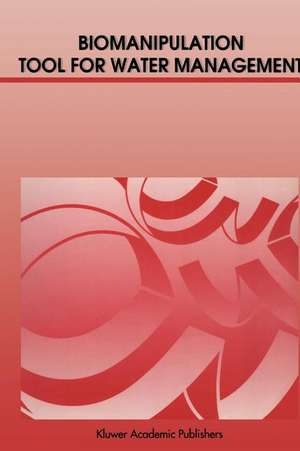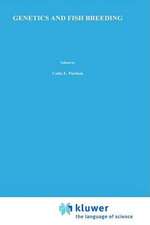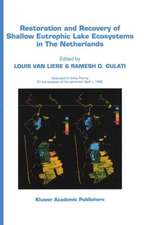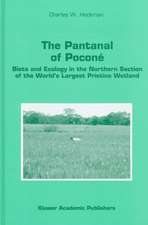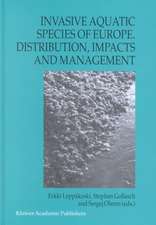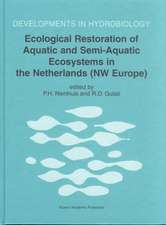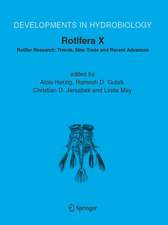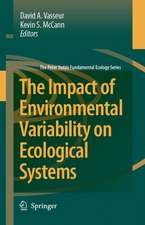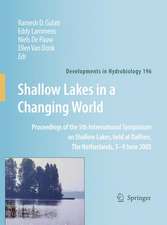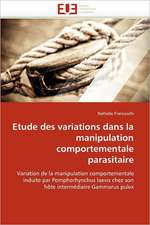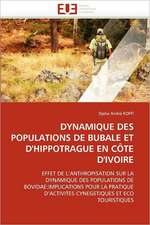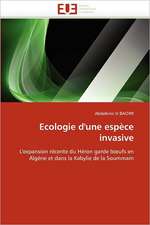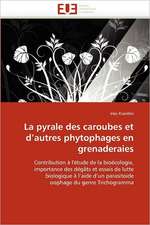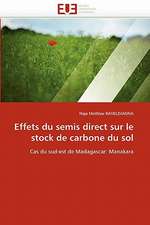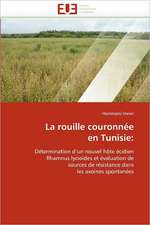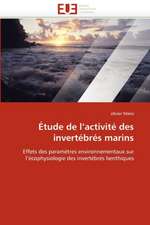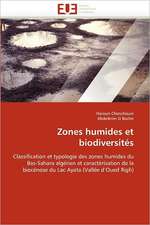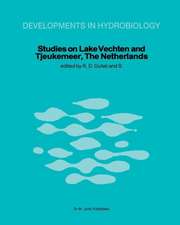Biomanipulation Tool for Water Management: Proceedings of an International Conference held in Amsterdam, The Netherlands, 8–11 August, 1989: Developments in Hydrobiology, cartea 61
Editat de Ramesh D. Gulati, E.H.R.R. Lammens, M.-L. Meyer, E. van Donken Limba Engleză Hardback – 30 sep 1990
| Toate formatele și edițiile | Preț | Express |
|---|---|---|
| Paperback (1) | 1850.52 lei 6-8 săpt. | |
| SPRINGER NETHERLANDS – 28 ian 2011 | 1850.52 lei 6-8 săpt. | |
| Hardback (1) | 1847.35 lei 6-8 săpt. | |
| SPRINGER NETHERLANDS – 30 sep 1990 | 1847.35 lei 6-8 săpt. |
Din seria Developments in Hydrobiology
- 18%
 Preț: 1229.10 lei
Preț: 1229.10 lei - 18%
 Preț: 959.98 lei
Preț: 959.98 lei - 18%
 Preț: 963.91 lei
Preț: 963.91 lei - 15%
 Preț: 648.24 lei
Preț: 648.24 lei - 15%
 Preț: 637.89 lei
Preț: 637.89 lei -
 Preț: 378.23 lei
Preț: 378.23 lei - 15%
 Preț: 644.95 lei
Preț: 644.95 lei - 18%
 Preț: 952.09 lei
Preț: 952.09 lei - 20%
 Preț: 558.87 lei
Preț: 558.87 lei - 18%
 Preț: 1833.65 lei
Preț: 1833.65 lei -
 Preț: 393.59 lei
Preț: 393.59 lei -
 Preț: 406.54 lei
Preț: 406.54 lei - 18%
 Preț: 1226.73 lei
Preț: 1226.73 lei - 18%
 Preț: 956.99 lei
Preț: 956.99 lei -
 Preț: 388.87 lei
Preț: 388.87 lei - 24%
 Preț: 1060.51 lei
Preț: 1060.51 lei - 18%
 Preț: 1229.28 lei
Preț: 1229.28 lei - 20%
 Preț: 569.30 lei
Preț: 569.30 lei -
 Preț: 368.79 lei
Preț: 368.79 lei - 24%
 Preț: 817.46 lei
Preț: 817.46 lei - 18%
 Preț: 958.25 lei
Preț: 958.25 lei - 18%
 Preț: 953.03 lei
Preț: 953.03 lei -
 Preț: 384.75 lei
Preț: 384.75 lei - 24%
 Preț: 1582.91 lei
Preț: 1582.91 lei - 24%
 Preț: 1051.68 lei
Preț: 1051.68 lei - 18%
 Preț: 943.57 lei
Preț: 943.57 lei - 18%
 Preț: 1235.76 lei
Preț: 1235.76 lei - 24%
 Preț: 800.02 lei
Preț: 800.02 lei - 24%
 Preț: 803.55 lei
Preț: 803.55 lei - 18%
 Preț: 948.29 lei
Preț: 948.29 lei
Preț: 1847.35 lei
Preț vechi: 2252.86 lei
-18% Nou
Puncte Express: 2771
Preț estimativ în valută:
353.54€ • 365.22$ • 294.23£
353.54€ • 365.22$ • 294.23£
Carte tipărită la comandă
Livrare economică 25 martie-08 aprilie
Preluare comenzi: 021 569.72.76
Specificații
ISBN-13: 9780792308607
ISBN-10: 0792308603
Pagini: 628
Ilustrații: X, 628 p. 50 illus.
Dimensiuni: 193 x 260 x 35 mm
Greutate: 1.32 kg
Ediția:Reprinted from HYDROBIOLOGIA, 200/201, 1990
Editura: SPRINGER NETHERLANDS
Colecția Springer
Seria Developments in Hydrobiology
Locul publicării:Dordrecht, Netherlands
ISBN-10: 0792308603
Pagini: 628
Ilustrații: X, 628 p. 50 illus.
Dimensiuni: 193 x 260 x 35 mm
Greutate: 1.32 kg
Ediția:Reprinted from HYDROBIOLOGIA, 200/201, 1990
Editura: SPRINGER NETHERLANDS
Colecția Springer
Seria Developments in Hydrobiology
Locul publicării:Dordrecht, Netherlands
Public țintă
ResearchCuprins
One: Biomanipulation: Past, Present and Future.- Biomanipulation: retrospective and future development.- Biomanipulation: the next phase — making it stable.- Two: Zooplankton—Phytoplankton Interactions.- Are blue-green algae a suitable food for zooplankton? An overview.- Effectiveness of phytoplankton control by large-bodied and small-bodied zooplankton.- Analysis of phytoplankton—zooplankton relationships in an oligotrophic lake under natural and manipulated conditions.- Biomanipulation by introduction of herbivorous zooplankton. A helpful shock for eutrophic lakes?.- The zooplankton—phytoplankton interface in lakes of contrasting trophic status: an experimental comparison.- Why do cladocerans fail to control algal blooms?.- Structural and grazing responses of zooplankton community to biomanipulation of some Dutch water bodies.- Three: Enclosure Studies.- Biomanipulation and food-web dynamics — the importance of seasonal stability.- Impact of whitefish on an enclosure ecosystem in a shallow eutrophic lake: selective feeding of fish and predation effects on the zooplankton communities.- Impact of whitefish on an enclosure ecosystem in a shallow eutrophic lake: changes in nutrient concentrations, phytoplankton and zoobenthos.- A fading recovery: the role of roach (Rutilus rutilus L.) in maintaining high phytoplankton productivity and biomass in Lake Vesijärvi, southern Finland.- Bottom-up effects of bream (Abramis brama L.) in Lake Balaton.- Applicability of planktonic biomanipulation: for managing eutrophication in the subtropics.- Four: Whole Lake Studies.- Conditions for effective biomanipulation; conclusions derived from whole-lake experiments in Europe.- Fish manipulation as a lake restoration tool in shallow, eutrophie temperate lakes 1: cross-analysisof three Danish case-studies.- Fish manipulation as a lake restoration tool in shallow, eutrophic, temperate lakes 2: threshold levels, long-term stability and conclusions.- Phytoplankton biomass reduction after planktivorous fish reduction in a shallow, eutrophie lake: a combined effect of reduced internal P-loading and increased zooplankton grazing.- Ecological consequences of a manual reduction of roach and bream in a eutrophic, temperate lake.- Predictability and possible mechanisms of plankton response to reduction of planktivorous fish.- Oligotrophication as a result of planktivorous fish removal with rotenone in the small, eutrophic, Lake Mosvatn, Norway.- Whole-lake food-web manipulation as a means to study community interactions in a small ecosystem.- First attempt to apply whole-lake food-web manipulation on a large scale in The Netherlands.- Is reduction of the benthivorous fish an important cause of high transparency following biomanipulation in shallow lakes?.- Early responses of plankton and turbidity to biomanipulation in a shallow prairie lake.- Effects of planktivorous fish mass mortality on the plankton community of Lake Mendota, Wisconsin: implications for biomanipulation.- Effects of planktivore abundance on chlorophyll-a and Secchi depth.- Factors related to variance of residuals in chlorophyll-total phosphorus regressions in lakes and reservoirs of Argentina.- Three years of experience in biomanipulating a small eutrophic lake: Lago di Candia (Northern Italy).- Five: Macrophytes.- Engineering and biological approaches to the restoration from eutrophication of shallow lakes in which aquatic plant communities are important components.- The potential of artificial refugia for maintaining a community of large-bodied cladocera against fish predation ina shallow eutrophic lake.- Ecosystem development in different types of littoral enclosures.- Can macrophytes be useful in biomanipulation of lakes? The Lake Zwemlust example.- Biomanipulation of Lago di Candia (Northern Italy): a three-year experience of aquatic macrophyte management.- Impact of mechanical deweeding on Dal lake ecosystem.- Proposals for macrophyte restoration in eutrophic coastal lagoons.- Six: Macrofauna.- Zebra mussels (Dreissena polymorpha): a new perspective for water quality management.- Shoals of Dreissena polymorpha as bio-processor of seston.- Evaluation of Chaoborus predation on natural populations of herbivorous zooplankton in a eutrophic lake.- Hydrophyte-macroinvertebrate interactions in Zwemlust, a lake undergoing biomanipulation.- Seven: Models.- Multiplicity of stable states in freshwater systems.- Quantifying the food webs of Lake Bleiswijkse Zoom and Lake Zwemlust.- Production, consumption and prey availability of northern pike (Esox lucius), pikeperch (Stizostedion lucioperca) and European catfish (Silurus glanis): a bioenergetics approach.- Growth and food consumption of vendace (Coregonus albula (L.)) in Lake Pyhäjärvi, SW Finland a bioenergetics modeling analysis.- Eight: Management.- Biomanipulation additional to nutrient control for restoration of shallow lakes in The Netherlands.- Biomanipulation development in Norway.- A review-limnological management and biomanipulation in the London reservoirs.- The potential for biomanipulation using fry communities in a lowland reservoir: concordance between water quality and optimal recruitment.- The restoration of shallow eutrophic lakes, and the role of northern pike, aquatic vegetation and nutrient concentration.- Effects of planktivorous fishes on the plankton community in aeutrophic lake.- Experimental study of the impacts of planktivorous fishes on plankton community and eutrophication of a tropical Brazilian reservoir.- Some positive and negative effects of stocking whitefish on the ecosystem redevelopment of Hjarbœk Fjord, Denmark.- Zooplankton impacts on chlorophyll and transparency in Onondaga Lake, New York, USA.- Nine: Synthesis.- The first biomanipulation conference: a synthesis.
Recenzii
` In conclusion, this book is strongly recommended for anyone involved in eutrophication control. More generally, it provides useful and stimulating information for ecologists interested in trophic interactions in lacustrine communities. '
Acta Oecologica
Acta Oecologica
